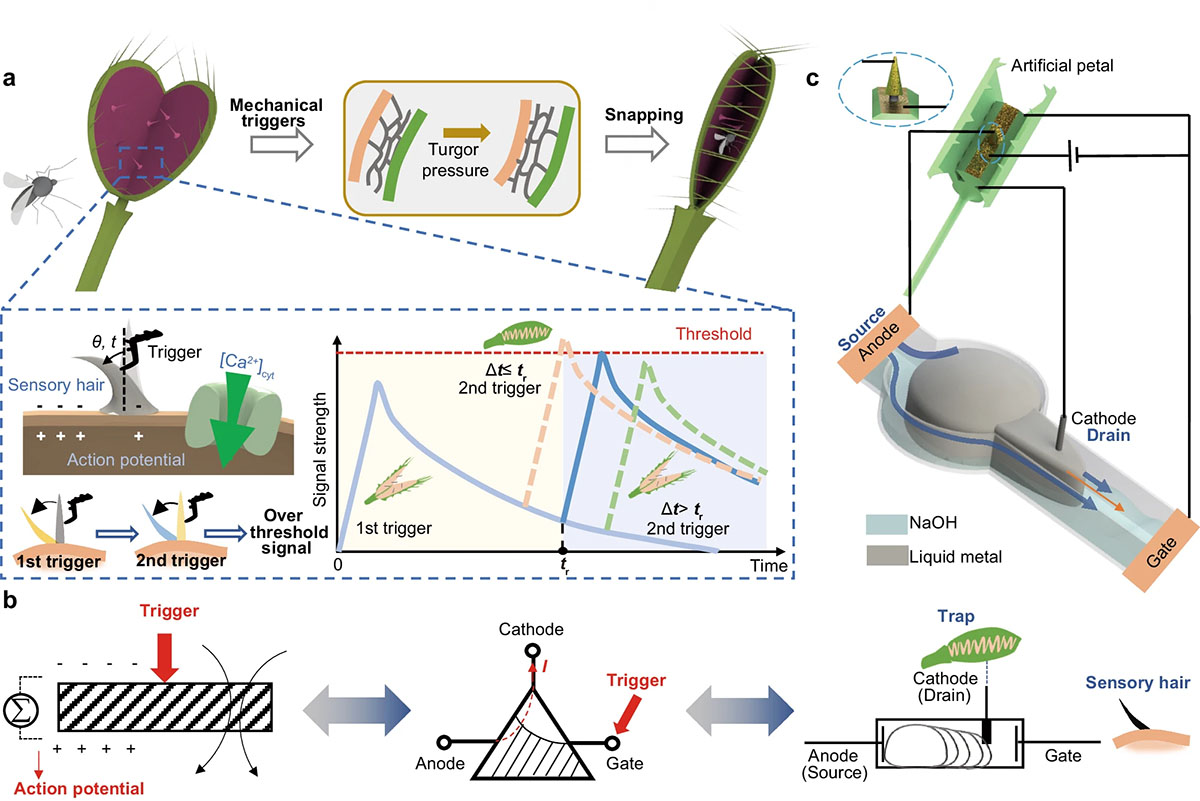| Jun 06, 2024 |
Researcher developed liquid metal-based electronic logic device that mimics intelligent prey-capture mechanism of Venus flytrap
(Nanowerk News) A research team led by the School of Engineering of the Hong Kong University of Science and Technology (HKUST) has developed a liquid metal-based electronic logic device that mimics the intelligent prey-capture mechanism of Venus flytraps. Exhibiting memory and counting properties, the device can intelligently respond to various stimulus sequences without the need for additional electronic components.
|
|
The intelligent strategies and logic mechanisms in the device provide a fresh perspective on understanding “intelligence” in nature and offer inspiration for the development of “embodied intelligence”.
|
|
The findings have been published in Nature Communications ("A liquid metal-based module emulating the intelligent preying logic of flytrap").
|
 |
| Venus flytrap-inspired liquid metal-based logic module. (Image: HKUST) (click on image to enlarge)
|
|
The unique prey-capture mechanism of Venus flytraps has always been an intriguing research focus in the realm of biological intelligence. This mechanism allows them to effectively distinguish between various external stimuli such as single and double touches, thereby distinguishing between environmental disturbances such as raindrops (single touch) and insects (double touches), ensuring successful prey capture.
|
|
This functionality is primarily attributed to the sensory hairs on the carnivorous plants, which exhibit features akin to memory and counting, enabling them to perceive stimuli, generate action potentials (a change of electrical signals in cells in response to stimulus), and remember the stimuli for a short duration.
|
|
Inspired by the internal electrical signal accumulation/decay model of Venus flytraps, Prof. SHEN Yajing, Associate Professor of the Department of Electronic and Computer Engineering (ECE) at HKUST, who led the research, joined hands with his former PhD student at City University of Hong Kong, Dr. YANG Yuanyuan, now Associate Professor at Xiamen University, proposed a liquid metal-based logic module (LLM) based on the extension/contraction deformation of liquid metal wires.
|
|
The device employs liquid metal wires in sodium hydroxide solution as the conductive medium, controlling the length of the liquid metal wires based on electrochemical effects, thereby regulating cathode output according to the stimuli applied to the anode and gate. Research results demonstrate that the LLM itself can memorize the duration and interval of electrical stimuli, calculate the accumulation of signals from multiple stimuli, and exhibit significant logical functions similar to those of Venus flytraps.
|
|
To demonstrate, Prof. Shen and Dr. Yang constructed an artificial Venus flytrap system comprising the LLM intelligent decision-making device, switch-based sensory hair, and soft electric actuator-based petal, replicating the predation process of Venus flytraps.
|
|
Furthermore, they showcased the potential applications of LLM in functional circuit integration, filtering, artificial neural networks, and more. Their work not only provides insights into simulating intelligent behaviors in plants, but also serves as a reliable reference for the development of subsequent biological signal simulator devices and biologically inspired intelligent systems.
|
|
“When people mention ‘artificial intelligence’, they generally think of intelligence that mimics animal nervous systems. However, in nature, many plants can also demonstrate intelligence through specific material and structural combinations. Research in this direction provides a new perspective and approach for us to understand ‘intelligence’ in nature and construct ‘life-like intelligence’,” said Prof. Shen.
|
|
“Several years ago, when Dr. Yang was still pursuing her PhD in my research group, we discussed the idea of constructing intelligent entities inspired by plants together. It is gratifying that after several years of effort, we have achieved the conceptual verification and simulation of Venus flytrap intelligence. However, it is worth noting that this work is still relatively preliminary, and there is much work to be done in the future, such as designing more efficient structures, reducing the size of devices, and improving system responsiveness,” added Prof. Shen.
|

